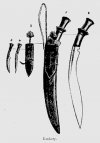- Joined
- Mar 26, 2009
- Messages
- 2,228
I've been looking for this woodcut for a while- saw it in college and never acquired even an electronic copy. We all know how little info there is on fighting with the khukuri other than "yell really loud and go for the neck"-this pic (and the attached article, which is new to me as of this AM) confirm something I had suspected: that the principle of attacking the incoming attack, rather than "blocking" was alive and well in pre-modern firearm Nepalese martial culture. The Japanese do it, the Filipinos and Indonesians do it...the text of the article explains my theory faster than I can reiterate it, but the woodcut was what got me thinking back in college- note the visibly wrecked front paw of the (poor kitty) tiger:
And here's the article itself:
http://www.arco-iris.com/George/ghurka_wood.htm
Given the khukuris usual weight ( and my experiments with my Gelbu) I imagine it's based almost entirely on timing and not on speed. Especially when used on tigers...

And here's the article itself:
http://www.arco-iris.com/George/ghurka_wood.htm
Given the khukuris usual weight ( and my experiments with my Gelbu) I imagine it's based almost entirely on timing and not on speed. Especially when used on tigers...

